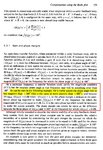E-design
Advanced Member level 5
Can a negative-feedback system ever have large positive phase shifts that causes instability?
All the examples in my old textbooks deal with instances where the overall phase shift approaches -180°.
How do we deal with instances of positive phase shifts near and beyond +180°?
I found this reference on the web that mentioned phase angles larger than +180°
It says that above +180° can be seen as above -180° (less negative i.e > -180°), and +180° is basically the same as -180°, if I read it correctly.
It appears that it takes the positive angle, say +200° and subtract -360° to get above -180° (-160° in this instance).
So, what about below 180°? Will say +150° be evaluated as it is? Surely it can't be seen as (+150 - 360° = -210°) because then it will suggest instability for all positive phase shifts with a gain more than 0dB, since the resulting angle will be more negative than -180°.
All the examples in my old textbooks deal with instances where the overall phase shift approaches -180°.
How do we deal with instances of positive phase shifts near and beyond +180°?
I found this reference on the web that mentioned phase angles larger than +180°
It says that above +180° can be seen as above -180° (less negative i.e > -180°), and +180° is basically the same as -180°, if I read it correctly.
It appears that it takes the positive angle, say +200° and subtract -360° to get above -180° (-160° in this instance).
So, what about below 180°? Will say +150° be evaluated as it is? Surely it can't be seen as (+150 - 360° = -210°) because then it will suggest instability for all positive phase shifts with a gain more than 0dB, since the resulting angle will be more negative than -180°.
Attachments
Last edited:
